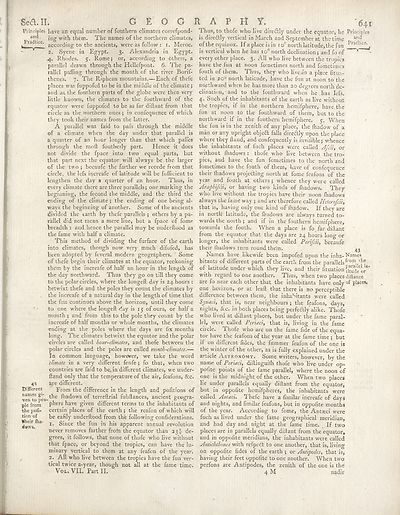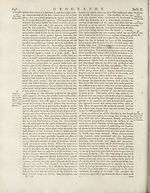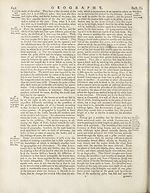Encyclopaedia Britannica > Volume 7, ETM-GOA
(689) Page 641
Download files
Complete book:
Individual page:
Thumbnail gallery: Grid view | List view

Sea. II. G E O G R
Principles have an equal number of fouthern climates correfpond-
ing with them. The names of the northern climates,
. fa lce‘ according to the ancients, were as follow : I. Meroe.
2. Syene in Egypt. 3. Alexandria in Egypt.
4. Rhodes. 5. Rome; or, according to others, a
parallel drawn through the Hellefpont. 6. The pa¬
rallel palling through the mouth of the river Borif-
thenes. 7. The Riphean mountains.—Each of thefe
places was fuppofed to be in the middle of the climate;
and as the fouthern parts of the globe were then very
little known, the climates to the fouthward of the
equator were fuppofed to be as far diftant from that
circle as the northern ones ; in confequence of which
they took their names from the latter.
A parallel was faid to pafs through the middle
of a climate when the day under that parallel is
a quarter of an hour longer than that which paffes
through the molt foutherly part. Hence it does
not divide the fpace into two equal parts, but
that part next the equator will always be the larger
of the two ; becaufe the farther we recede from that
A P H Y.
'641
Thus, to thofe who live dire&ly under the equator, he Principles
is direftly vertical in March and September at the time an<?
of the equinox. If a place is in io° north latitude,the fun Praaicc' f
is vertical when he has to° north declination; and fo of
every other place. 3. All who live between the tropics
have the fun at noon fometimes north and fometimes
fouth of them. Thus, they who live an a place fitua-
ted in 2c0 north latitude, have the fun at noon to the
northward when he has more than 20 degrees north de¬
clination, • and to the fouthward when he .has lefs.
4. Such of the inhabitants of the earth as live without
the tropics, if in the northern hemifphere, have the
fun at noon to the fouthward of them, but to the
northward if in the fouthern hemifphere. 5. When
the fun is in the zenith of any place, the fhadow of a
man or any upright objeft falls diredly upon the place
where they hand, and confequently is invifible; whence
the inhabitants of fuch places were called Afcli, or
without lhadows: thofe w'ho live between the tro¬
pics, and have the fun fometimes to the north and
fometimes to the fouth of them, have of confequence
circle, the lefs increafe of latitude will be fufficient to their lhadows projecting north at fome feafons of the
lengthen the day a quarter of an hour. Thus,
every climate there are three parallels; one marking the
beginning, the fecond the middle, and the third the
ending of the climate ; the ending of one being al¬
ways the beginning of another. Some of the ancients
divided the earth by thefe parallels ; others by a pa¬
rallel did not mean a mere line, but a fpace of fome
breadth : and; hence the parallel may be underftood as
the fame w’ith half a climate.
This method of dividing the furface of the earth
into climates, though now very much' difufed, has
been adopted by feveral modern geographers. ' Some
year and fouth at others; whence they were called
Araphifcii, or having two kinds of lhadows. They
who live without the tropics have their noon ftiadows
always the fame way ; and are therefore called Heterofcii,
that is, having only one kind of fhadow. If they are
in nortlt latitude, the fhadows are always turned to¬
wards the north ; and if in the fouthern hemifphere,
towards the fouth. When a place is foi far diitant
from the equator that the days are 24 hours long or
longer, the inhabitants were called Perifcii, becaufe
their fhadows turn round them. 43
Names have likewife been impofed upon the inha-Names
of thefe begin their climates at the equator, reckoning bitants of different parts of the earth from the parallelsfrom t,ie
them by the increafe of half an hour in the length of of latitude under which they live, and their fituation
with regard to one anotber. Thus, when two places diftance
are fo near each other that the inhabitants have only of places,
one horizon, or at leaft that there is no perceptible
difference between them, the inhabitants w^ere called
Synaci, that is, near neighbours; the feafons, days,
nights, &c. in both places being perfeftly alike. Thofe
who lived at diftant places, but under the fame paral¬
lel, were called Periaei, that is, living in the fame
the day northward. Thus they go on till they come
to the polar circles, where the longeft day is 24 hours :
betwixt thefe and the poles they count the climates by
the increafe of a natural day in the length of time that
the fun continues above the horizon, until they come
to one where the longeft day is 15 of ours, or half a
month ; and from this to the pole they count by the
increafe of half months or whole months, the climates
ending at the poles where the days are fix months circle. Thofe who are on the fame fide of the equa-
long. The climates betwixt the equator and the polar tor have the feafons of the year at the fame time • but
circles are called hour-climates, and thofe between the if on different fides, the fummer feafon of the one is
polar circles and the poles are called month-climates.— the winter of the other, as is fully explained under the
In common language, howwer, we take the word article Astron6my. Some writers, however, by the
climate in a very different fenfe ; fo that, when two name of Periaci, diftinguifh thofe who live under op-
countries are faid to be. in different climates, wre under- pofite points of the fame parallel, where the noon of
ftand only that the temperature of the air, feafons, &c. one is the midnight of the other. When two places
are different. lie under parallels equally diftant from the equator.
From the difference in the length and pofitions of but in oppofite hemifpheres, the inhabitants were
the ftiadows of terreftrial fubftances, ancient geogra- called Anteeci. Thefe have a fimilar increafe of days
pie from phers have given different terms to the inhabitants of and nights, and fimilar feafons, but in oppofite months
the pofi- certain places of the earth; the reafon of which will -r A J'—~ r ■’ A
*j°r; °f be eafily underftood from the following confiderations.
dows 9 *' S*ncc the fun in his apparent annual revolution
never removes farther frofn the equator than 234- de¬
grees, it follows, that none of thofe who live without
that fpace, or beyond the tropics, can have the lu¬
minary vertical to them at any feafon of the year.
" All who live between the tropics have the fun ver-
Different
names gi-
of the year. According to fome, the Antasci were
fuch as lived under the fame geographical meridian,
and had day and night at the fame time. If two
places are in parallels equally diftant from the equator,
and in oppofite meridians, the inhabitants were called
Antichthones with refpeft to one another, that is, living
on oppofite fides of the earth ; or Antipodes, that is,
x _ having their feet oppofite to one another. When two
tical twice a-year, though not all at the fame time, perfons are Antipodes, the zenith of the one is the
Vol. VII. Part II.
4M
nadir
Principles have an equal number of fouthern climates correfpond-
ing with them. The names of the northern climates,
. fa lce‘ according to the ancients, were as follow : I. Meroe.
2. Syene in Egypt. 3. Alexandria in Egypt.
4. Rhodes. 5. Rome; or, according to others, a
parallel drawn through the Hellefpont. 6. The pa¬
rallel palling through the mouth of the river Borif-
thenes. 7. The Riphean mountains.—Each of thefe
places was fuppofed to be in the middle of the climate;
and as the fouthern parts of the globe were then very
little known, the climates to the fouthward of the
equator were fuppofed to be as far diftant from that
circle as the northern ones ; in confequence of which
they took their names from the latter.
A parallel was faid to pafs through the middle
of a climate when the day under that parallel is
a quarter of an hour longer than that which paffes
through the molt foutherly part. Hence it does
not divide the fpace into two equal parts, but
that part next the equator will always be the larger
of the two ; becaufe the farther we recede from that
A P H Y.
'641
Thus, to thofe who live dire&ly under the equator, he Principles
is direftly vertical in March and September at the time an<?
of the equinox. If a place is in io° north latitude,the fun Praaicc' f
is vertical when he has to° north declination; and fo of
every other place. 3. All who live between the tropics
have the fun at noon fometimes north and fometimes
fouth of them. Thus, they who live an a place fitua-
ted in 2c0 north latitude, have the fun at noon to the
northward when he has more than 20 degrees north de¬
clination, • and to the fouthward when he .has lefs.
4. Such of the inhabitants of the earth as live without
the tropics, if in the northern hemifphere, have the
fun at noon to the fouthward of them, but to the
northward if in the fouthern hemifphere. 5. When
the fun is in the zenith of any place, the fhadow of a
man or any upright objeft falls diredly upon the place
where they hand, and confequently is invifible; whence
the inhabitants of fuch places were called Afcli, or
without lhadows: thofe w'ho live between the tro¬
pics, and have the fun fometimes to the north and
fometimes to the fouth of them, have of confequence
circle, the lefs increafe of latitude will be fufficient to their lhadows projecting north at fome feafons of the
lengthen the day a quarter of an hour. Thus,
every climate there are three parallels; one marking the
beginning, the fecond the middle, and the third the
ending of the climate ; the ending of one being al¬
ways the beginning of another. Some of the ancients
divided the earth by thefe parallels ; others by a pa¬
rallel did not mean a mere line, but a fpace of fome
breadth : and; hence the parallel may be underftood as
the fame w’ith half a climate.
This method of dividing the furface of the earth
into climates, though now very much' difufed, has
been adopted by feveral modern geographers. ' Some
year and fouth at others; whence they were called
Araphifcii, or having two kinds of lhadows. They
who live without the tropics have their noon ftiadows
always the fame way ; and are therefore called Heterofcii,
that is, having only one kind of fhadow. If they are
in nortlt latitude, the fhadows are always turned to¬
wards the north ; and if in the fouthern hemifphere,
towards the fouth. When a place is foi far diitant
from the equator that the days are 24 hours long or
longer, the inhabitants were called Perifcii, becaufe
their fhadows turn round them. 43
Names have likewife been impofed upon the inha-Names
of thefe begin their climates at the equator, reckoning bitants of different parts of the earth from the parallelsfrom t,ie
them by the increafe of half an hour in the length of of latitude under which they live, and their fituation
with regard to one anotber. Thus, when two places diftance
are fo near each other that the inhabitants have only of places,
one horizon, or at leaft that there is no perceptible
difference between them, the inhabitants w^ere called
Synaci, that is, near neighbours; the feafons, days,
nights, &c. in both places being perfeftly alike. Thofe
who lived at diftant places, but under the fame paral¬
lel, were called Periaei, that is, living in the fame
the day northward. Thus they go on till they come
to the polar circles, where the longeft day is 24 hours :
betwixt thefe and the poles they count the climates by
the increafe of a natural day in the length of time that
the fun continues above the horizon, until they come
to one where the longeft day is 15 of ours, or half a
month ; and from this to the pole they count by the
increafe of half months or whole months, the climates
ending at the poles where the days are fix months circle. Thofe who are on the fame fide of the equa-
long. The climates betwixt the equator and the polar tor have the feafons of the year at the fame time • but
circles are called hour-climates, and thofe between the if on different fides, the fummer feafon of the one is
polar circles and the poles are called month-climates.— the winter of the other, as is fully explained under the
In common language, howwer, we take the word article Astron6my. Some writers, however, by the
climate in a very different fenfe ; fo that, when two name of Periaci, diftinguifh thofe who live under op-
countries are faid to be. in different climates, wre under- pofite points of the fame parallel, where the noon of
ftand only that the temperature of the air, feafons, &c. one is the midnight of the other. When two places
are different. lie under parallels equally diftant from the equator.
From the difference in the length and pofitions of but in oppofite hemifpheres, the inhabitants were
the ftiadows of terreftrial fubftances, ancient geogra- called Anteeci. Thefe have a fimilar increafe of days
pie from phers have given different terms to the inhabitants of and nights, and fimilar feafons, but in oppofite months
the pofi- certain places of the earth; the reafon of which will -r A J'—~ r ■’ A
*j°r; °f be eafily underftood from the following confiderations.
dows 9 *' S*ncc the fun in his apparent annual revolution
never removes farther frofn the equator than 234- de¬
grees, it follows, that none of thofe who live without
that fpace, or beyond the tropics, can have the lu¬
minary vertical to them at any feafon of the year.
" All who live between the tropics have the fun ver-
Different
names gi-
of the year. According to fome, the Antasci were
fuch as lived under the fame geographical meridian,
and had day and night at the fame time. If two
places are in parallels equally diftant from the equator,
and in oppofite meridians, the inhabitants were called
Antichthones with refpeft to one another, that is, living
on oppofite fides of the earth ; or Antipodes, that is,
x _ having their feet oppofite to one another. When two
tical twice a-year, though not all at the fame time, perfons are Antipodes, the zenith of the one is the
Vol. VII. Part II.
4M
nadir
Set display mode to:
![]() Universal Viewer |
Universal Viewer | ![]() Mirador |
Large image | Transcription
Mirador |
Large image | Transcription
Images and transcriptions on this page, including medium image downloads, may be used under the Creative Commons Attribution 4.0 International Licence unless otherwise stated. ![]()
| Encyclopaedia Britannica > Encyclopaedia Britannica > Volume 7, ETM-GOA > (689) Page 641 |
|---|
| Permanent URL | https://digital.nls.uk/189130186 |
|---|
| Attribution and copyright: |
|
|---|
| Description | Ten editions of 'Encyclopaedia Britannica', issued from 1768-1903, in 231 volumes. Originally issued in 100 weekly parts (3 volumes) between 1768 and 1771 by publishers: Colin Macfarquhar and Andrew Bell (Edinburgh); editor: William Smellie: engraver: Andrew Bell. Expanded editions in the 19th century featured more volumes and contributions from leading experts in their fields. Managed and published in Edinburgh up to the 9th edition (25 volumes, from 1875-1889); the 10th edition (1902-1903) re-issued the 9th edition, with 11 supplementary volumes. |
|---|---|
| Additional NLS resources: |
|

